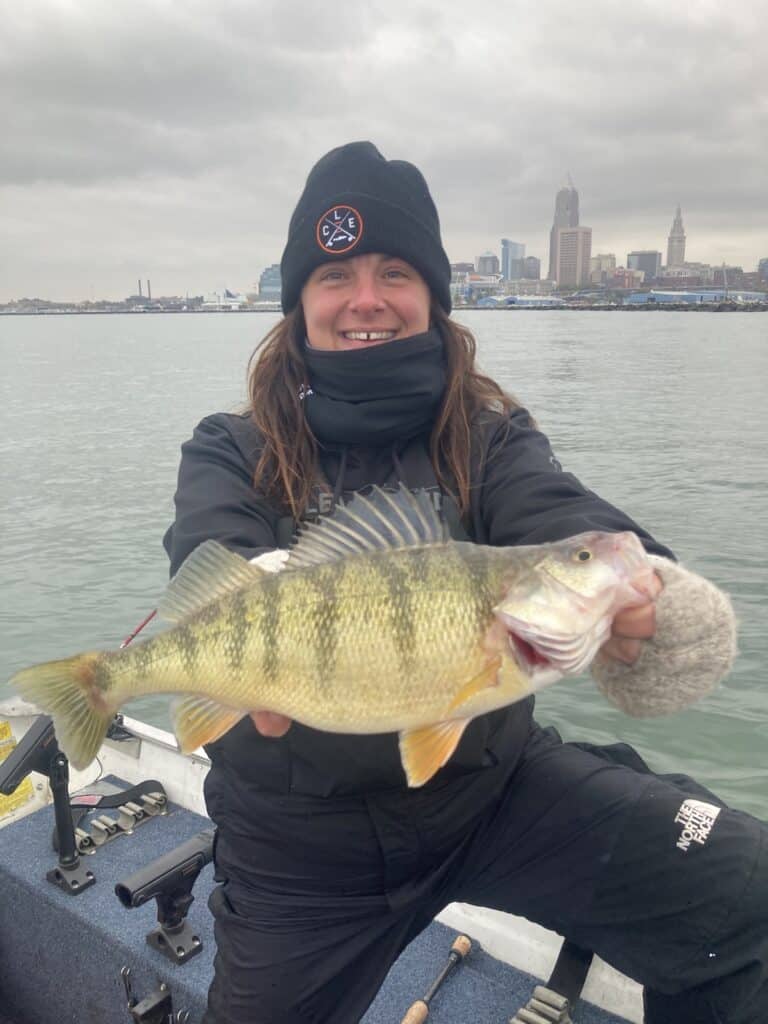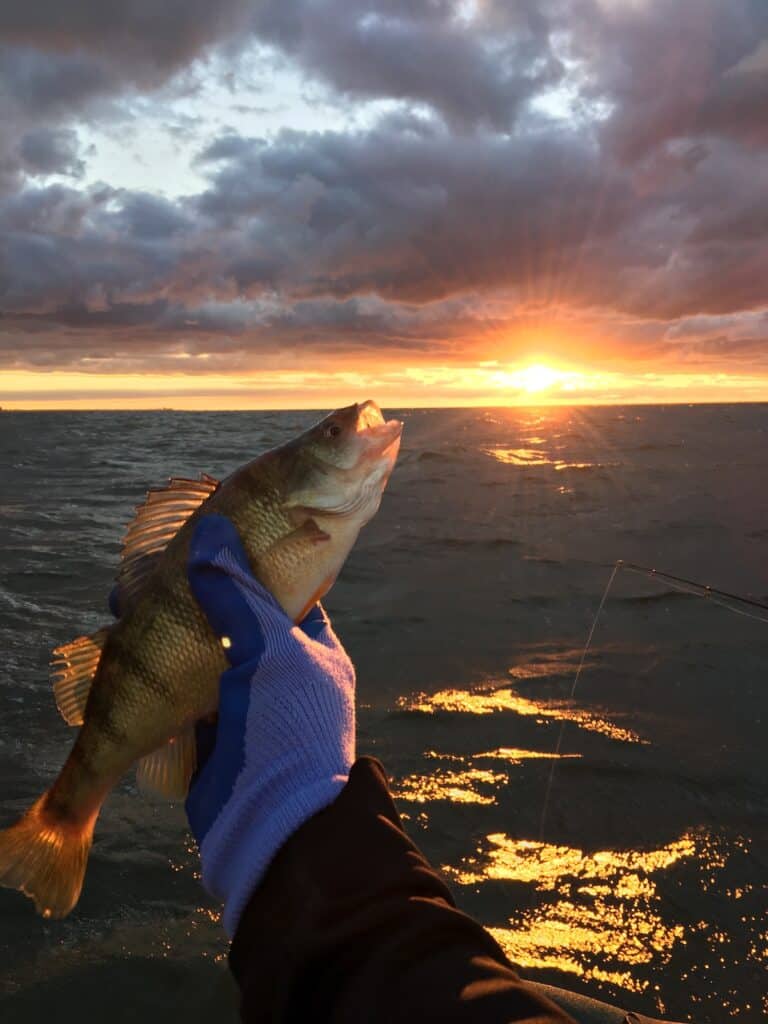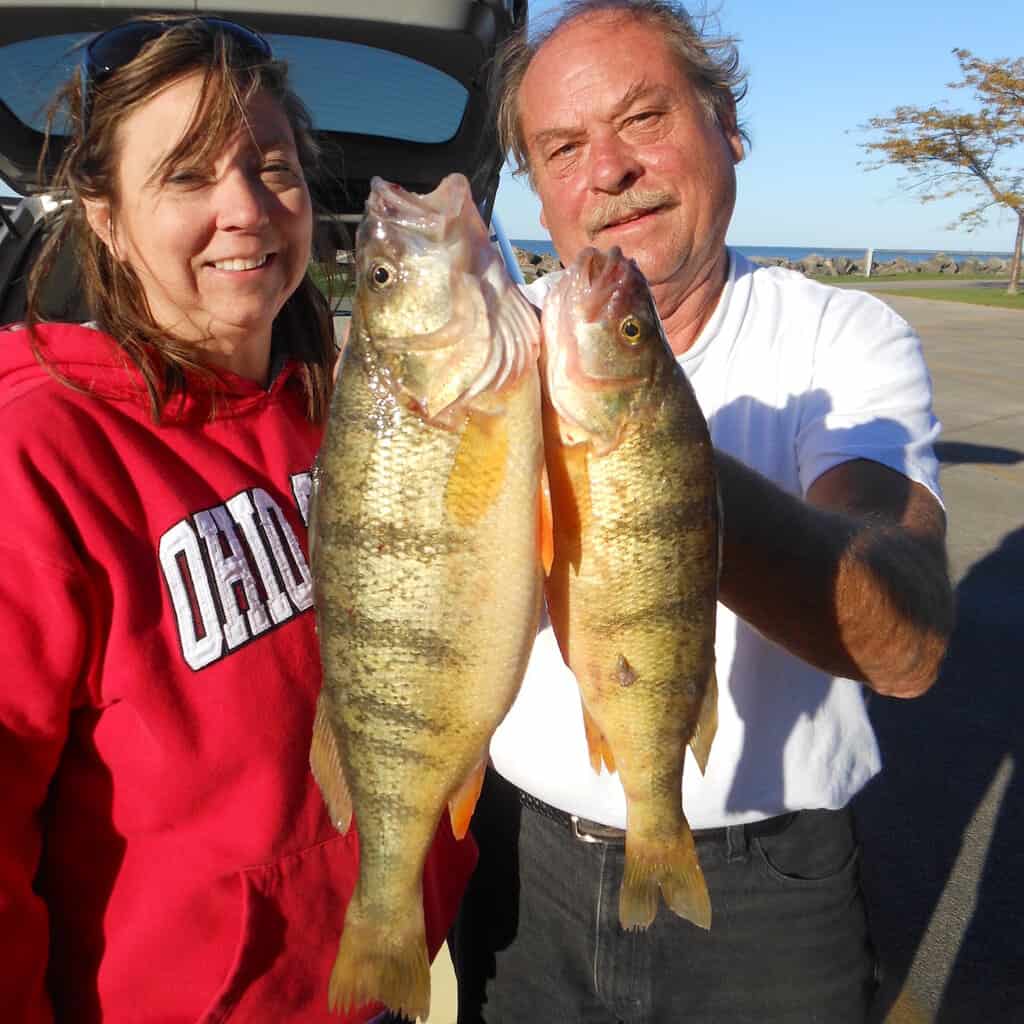Yellow perch are high up on many Ohio anglers’ list of favorite fish species. Tasty, abundant, and hard-fighting for their size, perch are hard not to love.
And while many of us are accustomed to catching 6-inch perch in weedy shallows, these fish also get surprisingly big in Ohio waters. It’s not uncommon to spend a day hauling in tenacious 9- to 11-inch perch one after another.
Ohio’s state record perch, a monster weighing 2.86 pounds and measuring over 15 inches, was caught from the shore of Lake Erie in 2016.
It’s entirely likely that some even bigger perch are swimming in Lake Erie or one of the other Ohio lakes on this list.
Lake Erie Yellow Perch Fishing

In the ranking of Ohio perch lakes, Lake Erie essentially comes in first, second and third. There are other lakes in the state where you can catch yellow perch, but none where these fish swim in such abundance and anglers catch them so reliably.
Lake Erie is divided into three basins, Western, Central and Eastern. The state of Ohio occupies a sizable chunk of real estate along the Western and Central Basins. The Western Basin extends eastward to the Huron area from the westernmost tip of the lake.
For perch fishing purposes, it’s helpful to break up the Central Basin into two separate pieces, one from Huron to Fairport Harbor, and another from Fairport Harbor to the Pennsylvania state line.
The transitional area between the Western and Central basins is also very much its own animal.
These distinctions matter because a large portion of Lake Erie’s yellow perch population is migratory, especially the largest perch. The best fishing generally moves from west to east as the season progresses.
Seasonal Movements of Lake Erie Perch
In spring, the Western Basin is the place to be. At ice-out, anglers pile up lots of perch measuring 10 inches and up from Lake Erie’s bays and harbors. Maumee Bay and Sandusky Bay are excellent early in the season.
Other key spring spots are the rocky reefs that dot the Western Basin of Lake Erie. One of the best is Niagara Reef, which tops out at about 6 feet with 20-foot depths all around it. The perch bite can be off the charts here in spring.
As the water warms in early summer, the action shifts eastward to the Lake Erie Islands. The area east of Green Island toward South Bass Island can be fantastic, and both Kelley Island Shoal and American Eagle Shoal are often very productive.
You may also find a strong early summer bite off the Marblehead Lighthouse; look for perch in about 25 feet of water here.
By the dog days of summer, the bite starts to turn on farther east as perch seek cooler waters. This is the time to fish what we’ll call the “Western-Central Basin” from Huron to Fairport Harbor.
Look for schools of perch around 35 feet deep off Ruggles Beach and the mouth of the Vermillion River. The latter offers many good bottom structures that can be identified using your electronics.
The Lorrain area also starts to cook as summer turns to fall.
Bill Janowich, a local perch expert, pointed us to a massive, irregular-shaped sandbar just northwest of Lorrain that is one of his go-to fall spots. “Very large perch live here,” he tells us.
Janowich also contributed his expertise to our yellow perch fishing guides linked at the bottom of this article.
The Conneut and Ashtabula areas near the Pennsylvania state line offer massive schools of 8- to 10-inch perch in September. Once the lake starts to cool back down in October, the Western Basin and Lake Erie Islands once again become more productive.
Lake Erie Perch Fishing Tactics

No matter what depth you’re fishing, one of the major keys to catching Lake Erie perch is keeping your bait close to the bottom. Yellow perch seldom rise more than a few feet off the bottom to take a bait.
Lake Erie perch anglers tie a tried-and-true setup they call a “perch rig.” This rig utilizes a bell sinker to keep the bait down and usually includes two hooks on 6- to 10-inch leaders above the sinker, attached to the main line via three-way swivels.
You can fish a rig like this stationary or drift it just above the bottom to cover a bit more water.
Use the lightest tackle you can get away with; a 4- to 6-pound line with #8 hooks on an ultralight spinning rod and reel is ideal. Ohio law allows up to three hooks on a line.
The bait of choice is emerald shiners. They’re perch’s natural forage in Lake Erie, and are available live at many bait shops near the lake. Frozen emerald shiners are also effective if live ones aren’t available, and any small minnow can do the trick.
These days, most perch fishermen avoid using nightcrawlers because they simply end up in the bellies of bait-stealing gobies. Ever since invasive round gobies started proliferating in the lake during the 1990s, anglers have had to adapt their approach.
Perch will also strike small spinners, diving crankbaits, and crappie jigs. Marabou jigs, small tubes, and split-tail soft plastics like Beetle Spin jigs are all effective.
Retrieve these small lures along the bottom or fish them suspended just above the bottom beneath a slip float on days when there’s some chop.
For bank anglers, fishing piers offer some of the best options on Lake Erie. Try piers like the Huron Fishing Pier, the Fairport Harbor Pier and Lorraine’s Mile Long Pier that provide access to fairly deep water.
Honorable Mentions
For those who wish to look beyond Lake Erie, Ohio does offer other yellow perch fishing options. The Ohio DNR stocks perch in several reservoirs across the state, and the lakes listed here are some of the best bets.
Findlay Reservoirs #1 and #2
Located in the city of Findlay in Northwest Ohio, Findlay Reservoir #1 and Findlay Reservoir #2 are neighboring upground reservoirs that were originally built as municipal water supplies in the 1950s and 60s. More recently, they’ve become known as great fishing lakes.
Yellow perch are some of the most sought-after fish in these lakes, along with walleye and channel catfish. Perch fishing can be challenging here, but the Ohio DNR stocks both lakes heavily with perch fingerlings annually.
Perch fishing in the two lakes tends to be somewhat cyclical. Some years, 186-acre Findlay Reservoir #1 offers the best perch bite. In other years, 644-acre Findlay Reservoir #2 is far better.
Long story short, be prepared to move around as you try to locate the best spot. The reservoirs have relatively featureless bottoms that lack traditional cover. However, drop-offs and the outer edges of the riprap that lines the shore often hold perch.
Vegetation, while sparse in the Findlay Reservoirs, is also a perch magnet.
Try fishing with live baits like wax worms, small minnows, or bits of nightcrawler close to the bottom. Some of the best perch fishing is through the ice in winter.
Boat ramps and floating fishing docks are available on both reservoirs, and both lakes’ entire shorelines are open to anglers through Riverbend-Findlay Reservoirs Park. Boats are limited to electric motors on Reservoir #1, and gas motors up to 9.9 hp on Reservoir #2.
Pymatuning Reservoir
Encompassing a vast 16,349 acres of water on the Ohio/Pennsylvania border, Pymatuning Reservoir is the largest man-made lake in either state. It’s best known as a fantastic walleye lake, but yellow perch are also incredibly abundant.
Perch inhabit areas throughout Pymatuning, but a lot of the best structure is in the southern basin, below the Route 85/285 causeway that bisects the lake from east to west. Of particular interest to both perch and walleye anglers are the many shallow humps in this basin.
Some of the best humps top out at 4 to 7 feet beneath the surface, with rocky drop-offs to nearby 20-plus foot depths. These are great places to find perch year-round, but especially in spring and fall.
Jigging spoons and blade baits tend to select for larger perch, and it’s common to find a school consisting entirely of 9- to 10-inch fish. Pymatuning State Park provides several boat ramps and bank fishing access on this part of the lake.
Submerged bridges are also important structures. Pymatuning was once a network of wetlands before the dam flooded the lowlands to create the reservoir. The southern basin of Pymatuning contains several sunken bridges that span the original creek channels and provide excellent cover for perch.
The states of Ohio and Pennsylvania allow anglers to fish from a boat anywhere on Pymatuning Reservoir with a fishing license from either state. Bank anglers need a license from the state where they are fishing.
More: Complete Guide to Pymatuning Lake Fishing
Ferguson and Metzger Reservoirs
Nestled side-by-side just a few miles from Lima in Western Ohio, Ferguson and Metzger Reservoirs are similar to Findlay Reservoirs #1 and #2.
Their reputation among perch anglers is also much the same: sometimes excellent, but often challenging.
Spanning 308 and 157 acres, respectively, Ferguson and Metzger Reservoirs are upground reservoirs used as water supplies for nearby Lima. The Ohio DNR stocks well over 100,000 perch fingerlings combined in these reservoirs yearly.
Some big ones are also caught here, especially by ice anglers. It’s not uncommon to pull fat 12-inch perch up through the ice, or to find one latched onto a jig intended for walleye or bass.
Spikes and wax worms are the most effective perch baits.
The drop-off along the south bank of Ferguson Reservoir is one of the most productive areas.
In Metzger Reservoir, try fishing in the area known as “the hump.” This rocky structure sits at a depth of about 18 feet and is a prime spring and fall perch haunt.
A hike and bike trail encircles the entire shorelines of both lakes, providing excellent bank access. Angler parking is available on Reservoir Road and the neighboring Tecumseh Interpretive Nature Preserve.
Only non-powered craft are allowed on both lakes.
Mogadore Reservoir
Northeast Ohio’s Mogadore Reservoir is an all-around solid multi-species fishing lake. Located just a short drive from Akron, the lake spans 1,104 acres and is especially known for outstanding panfish and largemouth bass fishing.
Crappie, bluegill and sunfish are all abundant. Yellow perch, while perhaps not being quite as common as the aforementioned species, also offer solid fishing opportunities.
Anglers catch many perch between 9 and 12 inches through the ice and during the open water season.
Crappie anglers often nab a few perch while fishing the west end of the lake in early spring.
Live minnows and small jigs are the chosen baits, and there’s a lot of productive wood and brush in this part of the lake at 8- to 15-foot depths.
The best time to catch perch here is right after ice-out, when they are often in shallow water and within reach of bank anglers.
The area around Congress Lake Road toward the eastern part of the lake is productive (fishing is not allowed from the bridge).
A primitive launch ramp is located just off the southern end of that bridge. Find the a more modern launch facility with a fishing pier just off Route 43 near the middle of the lake.
Fishing around Mogadore’s main island can also yield some big perch.
Fremont Reservoir
Western and Central Ohio are dotted with upground reservoirs. Pumps fill these man-made water basins from their sources, usually nearby streams.
The 90-acre Fremont Reservoir is a newer example of an upground reservoir that became a fishing destination. It was built in 2015.
These reservoirs tend to be ideal for yellow perch, as well as other species like walleye and channel catfish. The DNR annually stocks Fremont Reservoir with perch fingerlings and fry numbering in the millions.
Like the upground reservoirs covered above, the perch fishing in Fremont Reservoir can be hit-or-miss. It’s quite possible to get into a school of chunky 10-inch perch here, but it’s equally possible to walk away skunked.
The best bet is to focus your efforts on the three rocky reefs built on the bottom of the reservoir to provide fish habitat. Another key spot is the inlet structure near the lake’s south shore, which is best when pumps deliver fresh water.
Live bait tends to be the most effective.
You’ll likely fair best if you approach Fremont Reservoir as a multi-species fishery. In addition to perch, be prepared to catch crappie, bluegill, largemouth bass, and more.
Gas motors up to 10 hp are permitted. You’ll find a boat launch on the eastern shore.
Catch More Perch
While following the recommendations in this article will have you catching perch in Ohio in no time, up your game by checking out our simple guide to yellow perch fishing.
We also have a useful as well as a fun story with dozens of the best (and weirdest) baits you can use to catch yellow perch.

